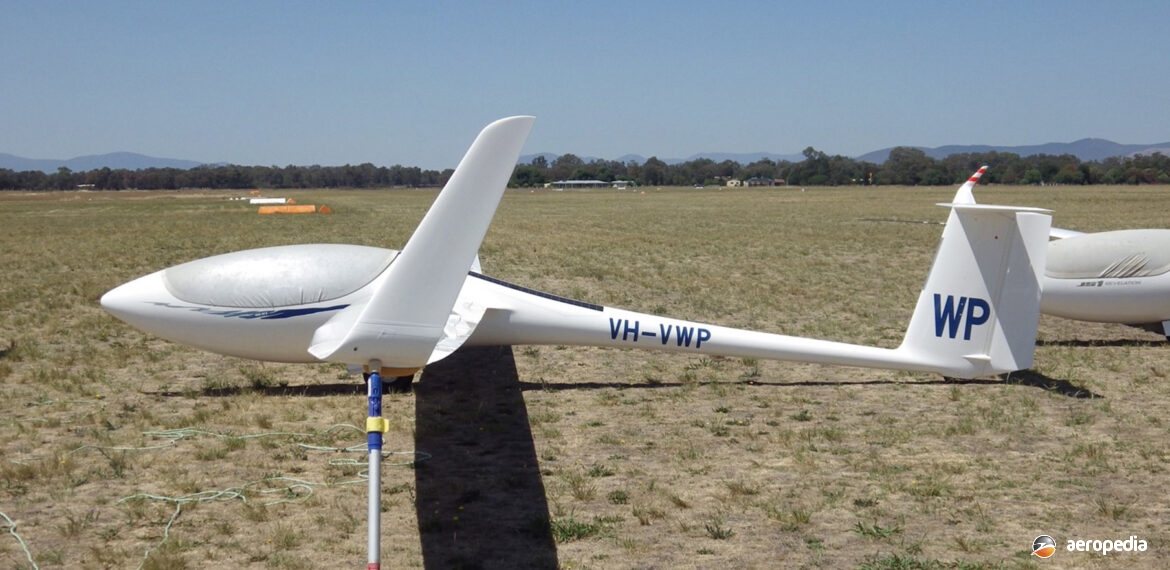Photograph:
Schleicher ASG 29E VH-VWP (c/n 29701) at Benalla, VIC in 2018 (David Carter)
Country of origin:
Germany
Description:
Single-seat glider with a sustainer engine
Power Plant:
One 18 kw (24 hp) SOLO 2350 two-cylinder, two-stroke, in-line air-cooled engine
Specifications:
- Wingspan: 18 m (59 ft)
- Wing area: 10.5 m² (113.02 sq ft)
- Wing aspect ratio: 30.9
- Max wing loading: 57 kg/m²
- Minimum sink rate: 28.1 m/min (92.5 ft/min)
- Best glide ratio: 50:1
- Fuel capacity: 10.5 litres (2.30 Imp gals)
- Empty weight: 325 kg (716 lb)
History:
The ASG 29 high-performance glider was designed in Germany and placed in production by Alexander Schleicher GmbH and Co, being a development of the ASW 27 series, the prototype flying for the first time on 9 November 2005, deliveries of machines beginning in 2006. It could be flown as an 18 m (59 ft) class glider or as a 15 m (49.2 ft) class glider. It was designed by Michael Greiner and, for certification purposes, it was listed as an ASW 27-18.
The structure was of composite carbon fibre, aramid and polyethylene fibre reinforced plastic, and was very light, but strong, being able to carry up to 170 litres (37 Imp gals – 146 kg / 322 lbs) of water ballast, this providing a wide range of wing loadings. It was available in two models, a non-motorised model which made its first flight on 9 November 2005; and the ASG 29E which had a self-sustaining SOLO engine, this model being made available at the request of operators and receiving certification in February 2008. This engine was a two-cylinder in-line two-stroke CDI ignition air-cooled engine which provided 19.6 kw (26 hp) for one minute at 5,500 rpm and weighed 16.8 kg (37 lb) without the 1.0 m (3.28 ft) propeller but with the muffler. The engine was extended and retracted by an electrical spindle drive which was provided to avoid outlandings, allowing pilots to participate in gliding safaris, exploring waves or extending flights.
The aircraft had a newly developed wing design which had a profile of 13% thickness. With an empty weight of 280 kg (617 lb) the wing area was 10.5 m² (113 sq ft) and this provided its performance and boosted aspect ratio to almost 31. Wing loading was 33 kg/m² (6.75 lb/sq ft) and this could be increased to 57.1 kg.m² (11.69 lb/sq ft). It could be operated as a 15 m (49.2 ft) or 18 m (59 ft) class glider and a wing-joint was located 5.5 m (18 ft) outboard of the fuselage centre, the aircraft having four wing panels. It had a high-performance wing profile with a blowhole boundary layer system, integrated with flaps and ailerons which tripped the laminar airflow as far back as 95% of the chord. The wing tanks held 85 litres (18.7 Imp gals) of water ballast each, and a 32 litre (7 Imp gals) fuselage tank was available.
The type proved very popular around the world, with twice as many powered gliders being built as non-powered aircraft, with more than 300 examples delivered. In Australasia most aircraft registered were the ASG 29E model. Examples of the ASG 29 non-powered variant included VH-ZDW (c/n 29009 – ex D-7633); VH-ZKE (c/n 29010 – ex D-8155); VH-YHK (c/n 29019 – ex D-0153); VH-XTK (c/n 29030 – ex D-6329); VH ZJB (c/n 29039) which later became VH-JPT; VH-ZBB (c/n 29030) which later became VH-GBB, and later again VH-GHS; and VH-YJT (c/n 29057).
Examples of the powered ASG 29E variant included: VH-GTF (c/n 29524 – ex D-KGGP); VH-IDJ (c/n 29525 – ex D-KDDI); ZK-GRB (c/n 29527 – ex D-KACT) which later became VH-IJB; VH-GQR (/n 29535); VH-VIT (c/n 29536); VH-GWS (c/n 29549 – ex G-CKRT); VH-VNL (c/n 29552); ZK-GRT (c/n 29561); VH-XBE (c/n 29564) which later became VH-EPT³; VH-GXM (c/n 29657 – ex D-KXMN); VH-VWP (c/n 29701); and VH-DIT (c/n 29720).

